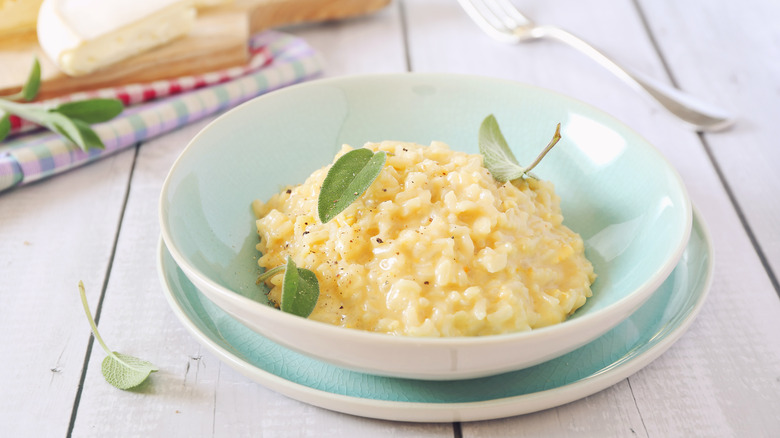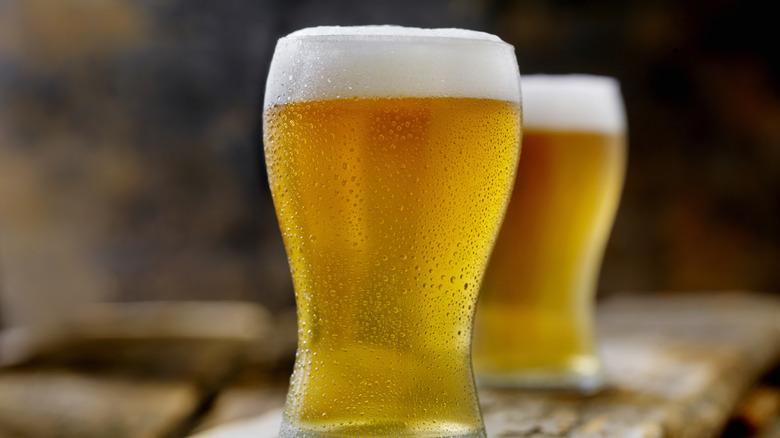Extra Beer On Hand? Make A Batch Of Cheesy Wisconsin-Style Risotto
Traditional risotto is a northern Italian meal made commonly with Arborio rice and cooked slowly with meat or vegetable stock until it is tender and silky. If you are unfamiliar with the glories of this dish, begin with this traditional take on Parmesan risotto. But if risotto is already your jam, you may be looking for ways to mix it up and try different takes on the recipe.
For something decadent and delicious, try putting a Midwestern spin on this classic Italian dish. The state of Wisconsin has a robust beer culture, informed by how in the 1800s, largely European immigrants settled in the area, bringing with them their artisan approach to beer. Since traditional risotto often calls for white wine, making risotto with beer is a satisfying way to infuse the dish with a different flavor profile. By channeling the rich flavors of Wisconsin, your northern Italian risotto will transform completely — and deliciously.
How to make Wisconsin-style risotto
For inspiration, start with this recipe by A.E. Dwyer for The Takeout. Dwyer's recipe for Wisconsin-style risotto depends on swapping out the traditional ingredients in risotto for things that more closely represent the Midwest. This begins with exchanging the traditional white wine for beer, and the onions or shallots for caramelized onions. Though white wine usually gets added to the risotto only in the beginning, Dwyer recommends adding beer twice — once at the beginning and once toward the end to boost the beer flavor.
Some recipes recommend using a lager, while others have used pale ale, pilsners, or Cocoon beer, an Italian brew made with mulberries that is slightly acidic and herbal. And if you want the flavor but still aren't sure about adding beer directly to your risotto, MasterChef's Graham Elliot makes his risotto with beer-braised onions.
Instead of Parmesan cheese, use a classic Wisconsin smoked cheddar. This cheese has a deeper and richer flavor and goes better with the other ingredients in this recipe variation. Finally, it wouldn't be Wisconsin-style risotto without bratwurst. Traditional risotto may or may not have a protein, but for this twist, some chopped bratwurst will do the trick. Other recipes have chosen bacon for the protein, which adds to the richness of the dish. One last optional addition — some chives for the top. This midwestern take on a classic dish is cheesy, rich, and exactly the type of risotto variation you've been looking for.
How does beer change risotto?
An early step in the traditional risotto-making process is adding a small amount of white wine. You add the wine when the Arborio rice grains are still hard, and the acid in the wine helps penetrate the grains and infuse them with a subtle but balanced flavor that will help even out the richness of the dish. However, there are many common substitutes for wine in this recipe, not the least of which is beer.
Beer is sent in to accomplish the same job as the wine. The idea is for it to establish a flavor threshold that the richer ingredients can build off of. As such, it should not be anything too bitter — dark beers can overtake the risotto in an unpleasant way. Instead, go for something lighter that will create the taste you want without being overpowering.
Though it is common today to finish traditional risotto with some butter or Parmesan cheese, the true creaminess in risotto comes from the low and slow method by which it is cooked, slowly transforming hard rice into the ultimate satisfying meal. Adding beer to this slow process infuses the dish with rich, hearty flavor, and makes it the perfect base for other savory ingredients like cheddar and sausage.


